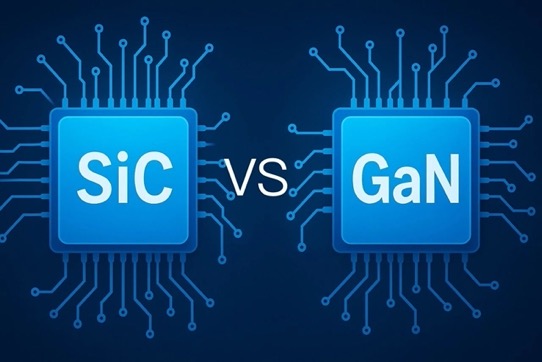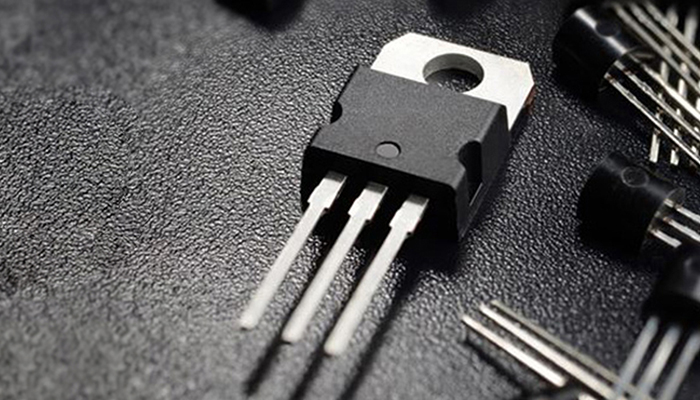SiC VS GaN semiconductor
With the rapid development of high-tech industries such as new energy, electric vehicles, 5G communications, and data centers, traditional silicon materials are gradually encountering bottlenecks. Third-generation semiconductor materials—silicon carbide (SiC) and gallium nitride (GaN)—are becoming the focus. With their higher voltage tolerance, lower energy consumption, and superior thermal performance, they are regarded as the core materials for this generation of power devices and RF devices.

What Are Third-Generation Semiconductors
Semiconductor materials can be broadly categorized into three generations based on their bandgap:
First Generation: Silicon (Si) and germanium (Ge), dominating traditional ICs, microprocessors, and circuits.
Second Generation: Gallium arsenide (GaAs) and indium phosphide (InP), mainly used in RF and optical communications.
Third Generation: Silicon carbide (SiC) and gallium nitride (GaN), which are wide-bandgap semiconductors.
Compared to silicon, SiC and GaN have larger bandgaps, higher breakdown voltages, faster switching speeds, and lower on-resistance, making them particularly suitable for high-frequency, high-voltage, and high-temperature environments. They are ideal materials for power electronics and RF communications.
Key Comparisons
Performance
Silicon Carbide (SiC): Breakdown electric field strength of 2.8 MV/cm, suitable for high-voltage scenarios above 1200V. It also has high thermal conductivity and outstanding high-temperature resistance. However, its substrate growth requires a high-temperature process of 2700°C, resulting in higher costs.
Gallium Nitride (GaN): Breakdown electric field strength of 3.3 MV/cm, switching frequencies reaching MHz levels, and lower power loss.
Cost
SiC substrates are expensive, but their compatibility with silicon-based TO-247 packaging allows for rapid replacement of traditional IGBTs.
GaN reduces costs by using silicon-based substrates, with 8-inch wafer production lowering single-device costs by 30%.
SiC is focusing on expanding 8-inch wafer production, while GaN is advancing vertical structures and monolithic integration technologies to break through the 1200V voltage barrier.
Applications
SiC Primarily is used in EV traction inverters, industrial power supplies, photovoltaic inverters, and power grid transmission/distribution systems.
GaN Mainly applies in consumer electronics, 5G RF power amplifiers, radar systems, and high-frequency communications.
Topdiode SiC MOSFET
Topdiode already supply SiC MOSFET cross to On Semi, ST, Infineon,etc.
| NO | Description | IFSM(A) | IF(AV) | Vds | VF(typ.) | QC(typ.) | Package | cross to | PN |
| TPDA10S65C1P | SIC SBD | 65A | 10A@158℃ | 650V | 1.36V | 25nC | TO-220-2 | Infineon | IDH10SG60C |
| ST | STPSC10065D | ||||||||
| On Semi | FFSP1065A | ||||||||
| TPDA15S65C1P | SIC SBD | 100A | 15A@155℃ | 650V | 1.38V | 41nC | TO-220-2 | Infineon | IDH16G65C6 |
| Littlelfuse | LSIC2SD065A16A | ||||||||
| On Semi | FFSP1665A | ||||||||
| TPDB20A65C1P | SIC SBD | 65A | 20A@158℃ | 650V | 1.36V | 25nC | TO-220-3 | FUJI | FDCP20C65 |
| On Semi | FFSP2065BDN-F085 | ||||||||
| TPDD20A120C1P | SIC SBD | 100A | 20A@164℃ | 1200V | 1.34V | 61.4nC | TO-247-3 | Infineon | IDW20G120C5B |
| On Semi | FFSH20120ADN-F155 | ||||||||
| ST | STPSC20H12C | ||||||||
| TPDD20A65C1P | SIC SBD | 65A | 20A@155℃ | 650V | 1.36V | 25nC | TO-247-3 | Infineon | IDW20G65C5B |
| On Semi | FFSH2065ADN-F155 | ||||||||
| Littlefuse | LFUSCD20065B | ||||||||
| TPDD30A65C1P | SIC SBD | 100A | 30A@155℃ | 650V | 1.36V | 41nC | TO-247-3 | On Semi | FFSH3065ADN-F155 |
| Infineon | IDW32G65C5B | ||||||||
| TPDD40A120C1P | SIC SBD | 190A | 40A@155℃ | 1200V | 1.33V | 131nC | TO-247-3 | On Semi | FFSH40120ADN-F155 |
| ST | STPSC40H12C | ||||||||
| Infineon | IDW40G120C5B | ||||||||
| TPDG10S65C1P | SIC SBD | 65A | 10A@148℃ | 650V | 1.36V | 25nC | TO-252 | Infineon | IDK10G65C5 |
| On Semi | FFSD1065B | ||||||||
| ST | STPSC10H065G-TR | ||||||||
| TPDG15S65C1P | SIC SBD | 100A | 15A@149℃ | 650V | 1.36V | 41nC | TO-263 | Infineon | AIDK16S65C5 |
| TPDG20A65C1P | SIC SBD | 65A | 20A@148℃ | 650V | 1.36V | 25nC | TO-263 | On Semi | FFSB2065BDN-F085 |
| TPDG5S65C1P | SIC SBD | 33A | 5A@157℃ | 650V | 1.40V | 16.2nC | TO-263 | Infineon | IDK05G65C5 |
| ST | STPSC6H065G-TR | ||||||||
| On Semi | FFSB0665A | ||||||||
| TPDH10S120C1P | SIC SBD | 100A | 10A@164℃ | 1200V | 1.34V | 61.4nC | TO-247-2 | On Semi | FFSH10120A |
| ST | STPSC10H12WL | ||||||||
| Infineon | IDWD10G120C5 | ||||||||
| TPDH10S150C1P | SIC SBD | 80A | 10A@155℃ | 1500V | 1.50V | 80nC | TO-247-2 | On Semi | FFSH10120A |
| ST | STPSC10H12WL | ||||||||
| Infineon | IDWD10G120C5 | ||||||||
| TPDH10S170C1P | SIC SBD | 85A | 10A@158℃ | 1700V | 1.45V | 88.4nC | TO-247-2 | Littlefuse | LSIC2SD170B10 |
| On Semi | NDSH10170A | ||||||||
| TPDH20S120C1P | SIC SBD | 190A | 20A@159℃ | 1200V | 1.33V | 131nC | TO-247-2 | ST | STPSC20H12WL |
| On Semi | FFSH20120A-F085 | ||||||||
| Infineon | IDWD20G120C5 | ||||||||
| TPDH40S120C1P | SIC SBD | 250A | 40A@143℃ | 1200V | 1.50V | 190nC | TO-247-2 | On Semi | NDSH40120C-F155 |
| Infineon | IDWD40G120C5 | ||||||||
| TPDH40S65C1P | SIC SBD | 230A | 40A@153℃ | 650V | 1.46V | 99nC | TO-247-2 | On Semi | FFSH4065A |
Market Landscape
In 2023, the global SiC power device market was valued at approximately 2 billion and is projected to reach 2 billion and is projected to reach 6.5 billion by 2028, with a compound annual growth rate (CAGR) exceeding 25%. Meanwhile, the GaN power device market was around 370 million in 2023 and is expected to grow to about 370 million in 2023 and is expected to grow to about 2 billion by 2028, demonstrating rapid expansion, particularly in consumer electronics and communications.
Fourth-generation semiconductor materials primarily include ultra-wide bandgap semiconductors such as gallium oxide (Ga₂O₃), diamond, and aluminum nitride (AlN), as well as ultra-narrow bandgap semiconductors like gallium antimonide (GaSb) and indium antimonide (InSb).
If you are looking for SiC MOSFET, please contact:luna@topdiode.com



